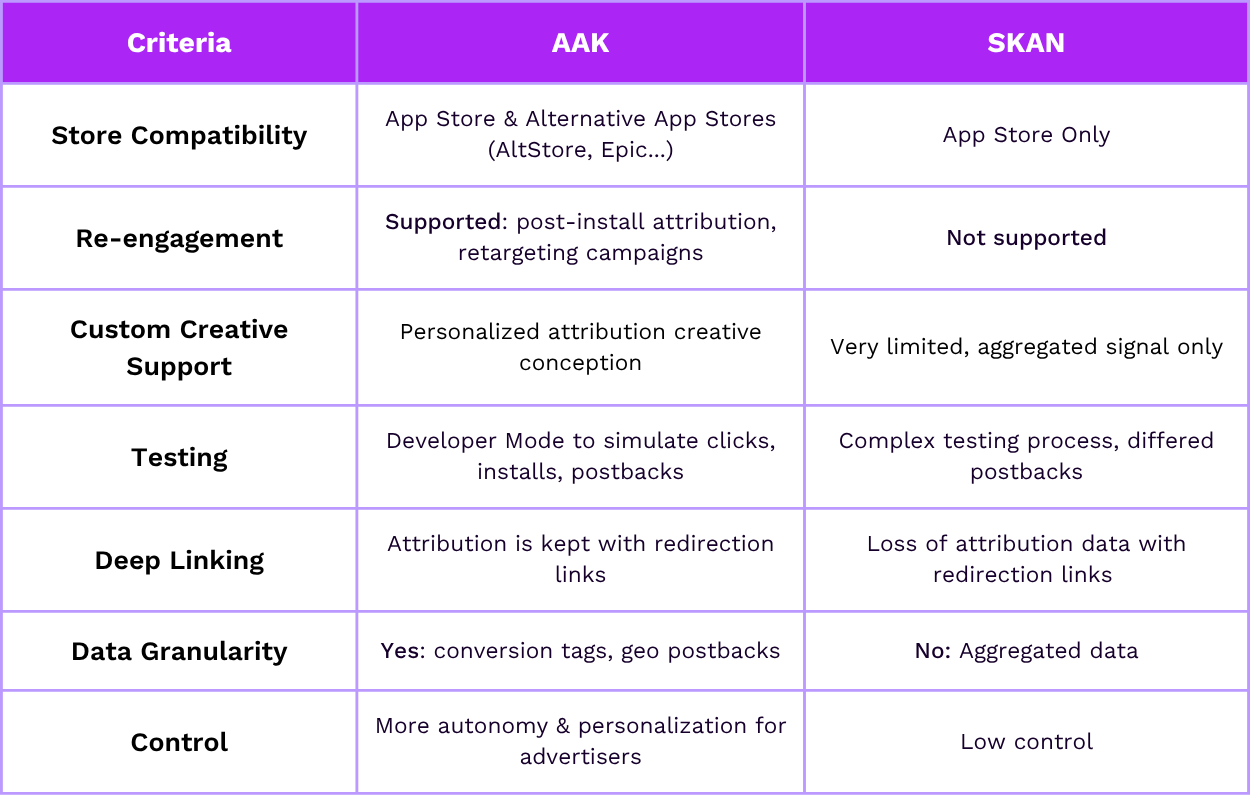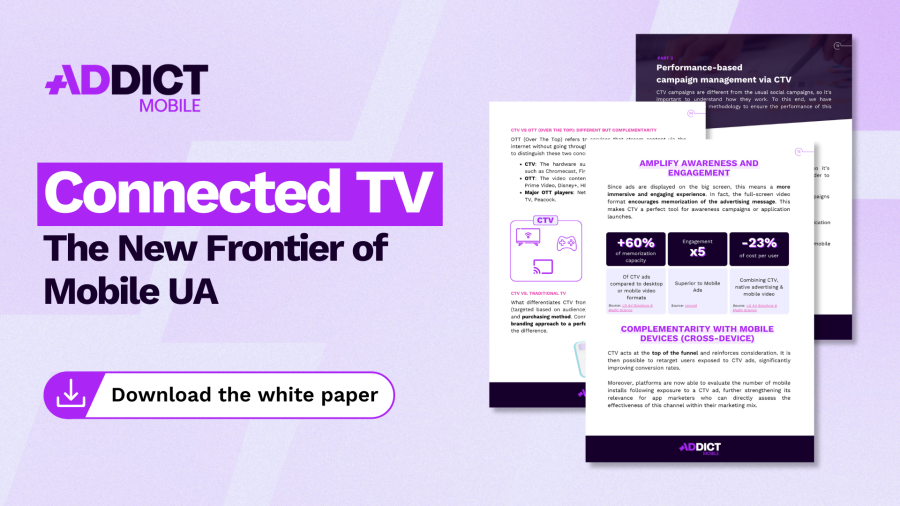Introduction
Since Apple introduced App Tracking Transparency (ATT), ad campaign attribution on iOS has become significantly more complex. SKAdNetwork (SKAN), Apple’s proposed solution, while useful, has its limitations. To address the current challenges of tracking and re-engagement, Apple launched the Ad Attribution Kit (AAK), a more flexible and open alternative, particularly designed for use with alternative App Stores.
On this page, you’ll learn what the Ad Attribution Kit is, how it differs from SKAN, the use cases it enables, the new features introduced in 2025 with iOS 18.4, and the concrete benefits it offers for your acquisition and re-engagement campaigns.
Definition of the Ad Attribution Kit
What is the Ad Attribution Kit?
The Ad Attribution Kit is an ad attribution framework introduced by Apple alongside App Tracking Transparency. Designed to work within both the traditional iOS ecosystem and alternative App Stores, it enables advertisers to measure the impact of advertising campaigns while respecting user privacy.
Unlike SKAN, AAK offers greater flexibility for customization and better interoperability with other marketing channels (deep links, push notifications, etc.).
What Is It For?
The Ad Attribution Kit (AAK) was designed to provide developers and marketers with an attribution solution that is more flexible, interoperable, and privacy-friendly than SKAdNetwork. Its main use cases include:
- Measuring the impact of ad campaigns: Identifying the origin of an installation (click or view), even without the presence of the IDFA.
- Facilitating testing and optimization: Thanks to its developer mode, different attribution scenarios can be simulated to refine activation mechanics.
- Re-engaging inactive users: By allowing post-install attribution, AAK enables tracking of re-engagement campaigns, which SKAN does not.
- Offering broader coverage: By being compatible with alternative App Stores, AAK supports the diversification of app distribution channels.
- Reinforcing deep linking strategies: AAK retains source signals when a user clicks on an ad containing a deep link, improving post-click analysis.
Ad Attribution Kit vs SKAN: What Are the Differences?
Although SKAdNetwork has long been the only solution offered by Apple for measuring ad attribution on iOS, the Ad Attribution Kit introduces a more flexible, modern approach, better suited to the evolving market. Below is a comparison of the main differences between the two frameworks.
Alternative App Stores Coverage
SKAN is exclusively tied to Apple’s App Store, limiting its usefulness in an environment where alternative App Stores (AltStore, Setapp, Epic Games Store…) are becoming increasingly common, especially in Europe.
AAK was designed to be agnostic to the distribution platform. This allows advertisers and developers to continue measuring ad attribution regardless of the app’s download channel.
Custom Creative Support
SKAN only supports a limited number of creative variants and provides only aggregated performance signals.
With AAK, campaigns can include personalized creative elements (banners, videos, interactive formats), and attribution takes these variations into account. This allows:
- Measuring the precise impact of each creative,
- Quickly testing creative hypotheses,
- Optimizing UA campaigns in a more granular way.
Easier Testing Through Developer Mode
One of SKAN’s weaknesses is the difficulty of conducting reliable testing: no real-time data, delayed postbacks, no debugging capabilities.
AAK offers a “developer mode” that allows:
- Simulating clicks, views, and installs,
- Forcing postbacks,
- Validating integration autonomously before going live.
This saves considerable time for UA and tech teams, who can validate their setups in controlled test environments.
Deep Linking
Deep linking is essential to the mobile user journey. With SKAN, deep redirections often result in lost attribution information.
AAK retains the trace of the user’s path, even when a deep link is involved, which enables:
- Better post-click traceability,
- Precise measurement of in-app conversions (page views, add to cart, etc.),
- Improved cross-channel user journeys.
Re-engagement
SKAN only supports the attribution of initial installations (user acquisition), which prevents tracking the effects of retargeting campaigns.
AAK, on the other hand, introduces a post-install attribution logic, allowing:
- Measuring the performance of reactivation campaigns,
- Identifying the most effective re-engagement channels,
Feeding this data into your CRM and push strategy.
Summary

Track and Re-engage Your Audiences with Ad Attribution Kit
With the introduction of deep links and re-engagement features, AAK proves to be a robust alternative to SKAN. Let’s look at how it works in practical terms.
Deep Linking: Better Tracking of User Activity
Thanks to its seamless integration with deep linking systems, Ad Attribution Kit allows you to accurately track user actions after installation. This significantly improves ROI analysis of your campaigns, particularly in the retail, gaming, or fintech sectors.
How Does AAK Enable Audience Re-engagement?
AAK introduces a logic of continuous attribution, even after the app is installed. This means it is now possible to:
- Identify inactive users,
- Target reactivation campaigns,
- Measure the impact of these actions while retaining the original source information.
This approach is valuable in a context where the user lifecycle is increasingly fragmented.
What’s New in 2025: iOS 18.4 Accelerates AAK Adoption
The year 2025 marks a major milestone with iOS 18.4 introducing several key features to the Ad Attribution Kit:
Multi-Re-engagement Attribution
Until now, only a single source could be credited per user. With iOS 18.4, AAK now allows:
- Multiple re-engagement campaigns to be attributed to the same user,
- The ability to distinguish successive sources of interaction,
- The measurement of the cumulative value of marketing efforts over time.
👉 Example: A user is reactivated by an email campaign, then a push notification, then a native ad. All of these actions can now be attributed.
Introduction of Conversion Tags
These tags allow developers to associate custom events with user actions, such as:
- Add to cart
- Account login
- Booking or subscription
Each tag is flexible and defined by the developer, enabling a precise understanding of the conversion funnel.
Customizable Attribution
Advertisers can now:
- Define the duration of the attribution window (default: 30 days),
- Choose the attribution model (last click, first click, etc.),
- Set specific rules per campaign.
This provides full autonomy in configuring attribution according to marketing objectives.
Geolocated Postbacks (Country Level)
AAK 2025 allows each postback to be associated with a geographical location (country-level granularity, without collecting personal data).
Benefits include:
- Analyzing performance by market,
- Optimizing budgets based on geography,
Adapting creatives to local preferences.
What Are the Concrete Benefits of These New Features?
More Control for Marketing Teams
With customizable attribution, marketing teams can adapt the rules based on:
- Business goals (acquisition, retention, reactivation),
- The nature of the app (freemium, e-commerce, service, etc.),
- The creative strategy in place.
Result: More accurate KPIs, deeper insight into results, and better collaboration between UA, Product, and CRM teams.
More Granular Analytics
Thanks to conversion tags and geolocated postbacks:
- It becomes possible to analyze performance by action type, not just by installation,
- Identify the most profitable geographical areas,
- Adapt advertising messages in a smarter and more relevant way.
Better Tracking of the User Lifecycle
Multi-reengagement attribution allows teams to:
- Better understand long-term user behavior,
- Adjust loyalty and retention strategies accordingly,
- Accurately measure the impact of CRM, cross-promo, or email marketing levers.
Compatibility with a More Open Ecosystem
With iOS becoming open to alternative App Stores in Europe, AAK is becoming an essential tool to:
- Continue tracking user acquisition campaigns,
- Maintain marketing performance despite the fragmentation of distribution channels,
- Prepare for a post-App Store future in mobile marketing.

Do not hesitate to contact with our teams
Addict can support you to improve your performance.
Conclusion
The Ad Attribution Kit represents a major evolution in iOS attribution. It offers a credible and effective alternative to SKAdNetwork: more flexible, compatible with diverse environments, and built with the future of mobile marketing in mind.
As the adoption of alternative App Stores accelerates and users become more demanding, integrating the Ad Attribution Kit into your marketing stack is no longer optional — it’s a strategic lever for performance, measurement, and privacy-compliant growth.



